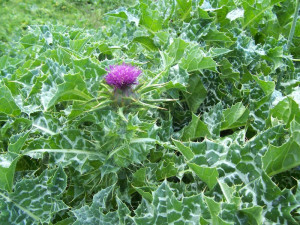Variegated thistle (Silybum marianum) is a large invasive biennial thistle native to the Mediterranean region, Europe, Central Asia and India. It first made itself at home in New Zealand in 1969.
Variegated thistle is classified as a Progressive Containment pest in the Tasman Nelson Regional Pest Management Plan and is required to be controlled annually by landowners.
The largest infestations occur in the Richmond foothills, where there are known populations that are controlled annually by landowners and our biosecurity staff.
Control is usually done by grubbing out thistles, although for larger infestations, herbicide is sometimes used.
These thistles normally develop very large rosettes and can grow up to 2.5m high and 2m wide. They normally produce large purple flower heads from November to January that are surrounded with spines.
Each flower head matures to produce 50 – 200 black or brown seeds that are attached to a pappus (fluffy plume). The plants die down later in summer after flowering and seeding has occurred.
A distinguishing feature of this thistle is its prominent white veins and blotches on its spiny leaves.
Another very widespread thistle in Tasman however, known as the winged thistle, is often confused with variegated thistle. Winged thistles produce variegated leaves, but they are lighter variegations and usually have a white tip on the spines of each leaf. They are also much smaller than variegated thistles.
Variegated thistle is very competitive and shades out other plants. It is known to be toxic to cattle and can reduce land productivity.


